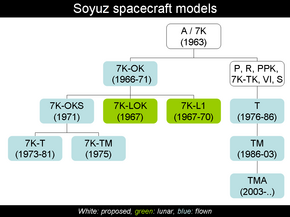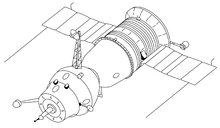Military Soyuz


The Soviet Union planned several military
Soyuz P, R and PPK
Soyuz P
The Soyuz P (Perekhvatchik, Interceptor) space interceptor and Soyuz R (Razvedki, intelligence) command-reconnaissance spacecraft was proposed in December 1962 by Sergei Korolev. In the initial draft project, the Soyuz P would use the Soyuz 9K rocket stage and Soyuz 11K tanker spacecraft to conduct a series of dockings and re-fueling operations. The complete complex would then conduct intercepts of enemy satellites in orbits up to 6,000 km in altitude. Soyuz P was cancelled in 1963. [3]
Soyuz R
The Soyuz-R system (1963-1966) consisted of two separately launched spacecraft, including the small orbital station 11F71 with photo-reconnaissance and electronic intelligence equipment and a Soyuz 7K-TK for crew transport. Soyuz R was cancelled in 1966.[4]
Soyuz PPK
Initially the Soyuz P was designed for piloted inspection and destruction of enemy satellites. It was intended that the Soyuz would rendezvous with the target satellite. To minimize risk to the crew, a new version, Soyuz PPK (pilotiruemovo korablya-perekhvatchika, crewed interceptor spacecraft) was later proposed in 1964.[5]
Soyuz 7K-VI Zvezda
The Zvezda (star) station was based on a radically modified Soyuz begun in October 1965.
Soyuz OIS (Orbital Research Station)
The Soyuz OIS (Orbital Research Station) would consist of a separately-launched orbital block 11F731 OB-VI and a transport Soyuz 7K-S.
Soyuz OB-VI
The Soyuz OB-VI would be launched for 30-day missions in a 51.6° orbit at 250 x 270 km. Power was provided by solar panels, and the payload included 700 to 1,000 kg of instrumentation. The total mass would be around 6,500 kg (14,300 lb).[8]
Soyuz 7K-S
The initial Soyuz 7K-S program was to consist of four uncrewed, followed by two crewed test flights, then two operational launches. Cosmonauts were assigned to the project in 1973.[6]
In 1975, the project was cancelled. At that time the launch escape system for 7K-S was ready and was used for Apollo-Soyuz Test Project flights. Three complete vehicles were launched as uncrewed test missions:
Soyuz 7K-ST
The Soyuz 7K-ST transport project was develop in parallel to the military 7K-S and was redesigned for a crew of three, eventually becoming the
Specifications
- Crew Size: 2
- Total Length: 7.5 m
- Maximum Diameter: 2.7 m
- Total Habitable Volume: 9.00 m3
- Total Mass: 6,800 kg
- Primary Engine Thrust: 400 kgf
- Main Engine Propellants: N2O4/UDMH
- Main Engine Isp: 305 seconds
- Electrical System: Solar panels
Relation with other Soyuz versions
The list below shows proposed, flown (in bold) and military (in italic) Soyuz versions.
- Soyuz A(1963)
- Soyuz 7K-OK (1967-71)
- Soyuz 7K-OKS (1971)
- Soyuz 7K-T (1973-81)
- Soyuz 7K-TM (1975)
- Soyuz 7K-OKS (1971)
- Soyuz 7K-LOK (1967)
- Soyuz 7K-L1 (1967-70)
- Soyuz 7K-L1E (1970-71)
- Soyuz 7K-L1 (1967-70)
- Soyuz P (1962)
- Soyuz PPK (1964)
- Soyuz R(1962)
- Soyuz 7K-TK (1966)
- Soyuz 7K-VI Zvezda(1964)
- Soyuz OIS (1967)
- Soyuz OB-VI (1967)
- Soyuz 7K-S(1974)
- Soyuz 7K-ST(1974)
- Soyuz 7K-OK (1967-71)
References
- ^ "NASA, Soyuz History, nasa.gov" (PDF).
- ^ I. B. Afanasyev, “Unknown Spacecraft (From the History of the Soviet Space Program),” What's New In Life, Science, and Technology: Space Program and Astronomy Series, No. 12, December 1991. Translated in JPRS Report, Science & Technology, Central Eurasia: Space (JPRS-USP-92003), May 27, 1992, p.6
- ^ "Soyuz P". www.astronautix.com.
- ^ "Soyuz R". www.astronautix.com.
- ^ "Soyuz PPK". www.astronautix.com.
- ^ a b "Soyuz 7K-S". www.astronautix.com.
- ^ "Soyuz VI". www.astronautix.com.
- ^ "Soyuz OB-VI". www.astronautix.com.
- ^ "Soyuz 7K-T". www.astronautix.com.
External links
This section's use of external links may not follow Wikipedia's policies or guidelines. (April 2023) |
- RSC Energia: Concept Of Russian Manned Space Navigation Development
- Mir Hardware Heritage
- David S.F. Portree, Mir Hardware Heritage, NASA RP-1357, 1995
- Mir Hardware Heritage (wikisource)
- Information on Soyuz spacecraft
- OMWorld's ASTP Docking Trainer Page
- NASA - Russian Soyuz TMA Spacecraft Details
- Space Adventures circum-lunar mission - details

